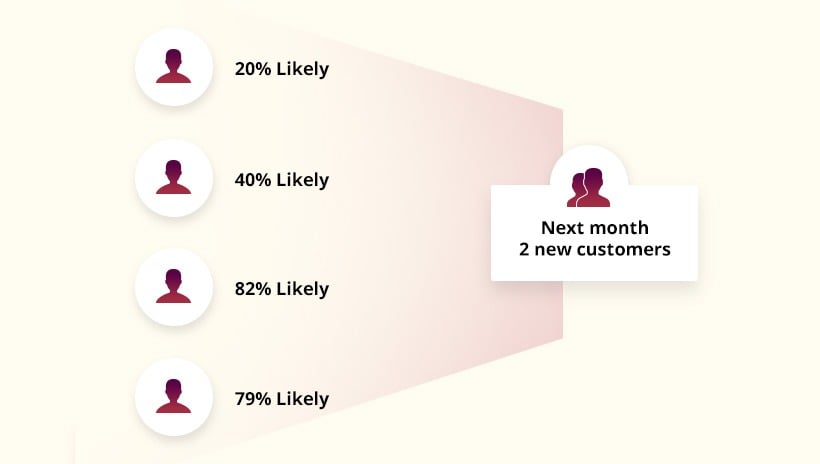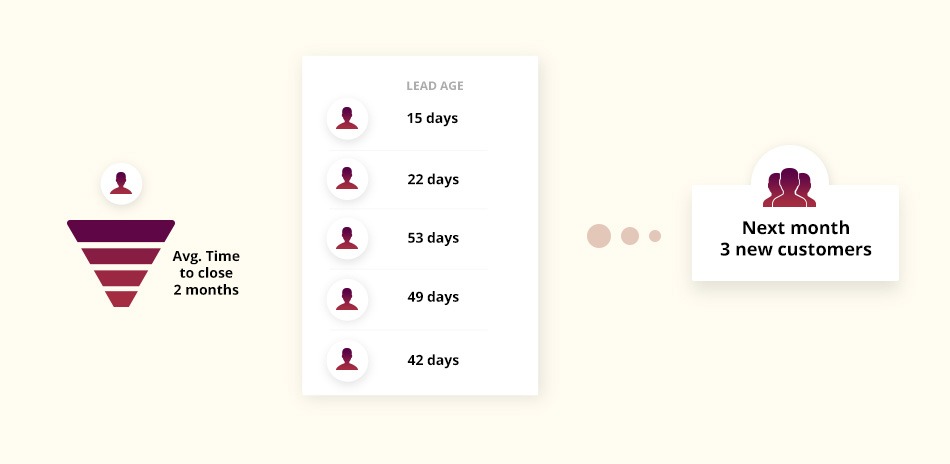
If someone were to ask you how much money in sales you expect to make in the next week (or month or year), would you be able to answer with certainty?
Sales prediction isn’t always easy to work, especially if you’re a new business with little financial history to base your estimates. But that shouldn’t stop you from taking advantage of the benefits sales prediction offers your company.
The Value of Sales Prediction
Sales prediction, or sales forecasting, allows businesses to predict how much revenue to expect in a given time frame. This information helps businesses to make informed decisions and estimate performance in the short and long terms.
For example, companies may use sales prediction to allocate budgets, manage the workforce, purchase equipment, and control cash flow. It can also be a contributing factor when seeking investment capital as you plan for future business growth.
What You Need for Accurate Sales Prediction
To gain an accurate view of your sales prediction, you’ll need the following information:
- Personal and team quotas
- A well-structured sales process
- A sales monitoring system
The only way to accurately predict sales is to have transparency in your sales process. You need to know when reps are hitting or missing quotas, where prospects are in your pipeline, and how reps are being held accountable for their share of the sales pie.
Factors that Affect Your Forecasting Accuracy

As long as reps are hitting their quotas, you should be able to predict your revenue flow, right?
Not so fast!
There are several internal and external factors that could impact the veracity of your sales predictions and should be accounted for:
Internal Factors
- Employee entrances and exits
- Changes to company policy or the sales process itself
- Changes to the sales rep pay scale
- Shifts in sales territories
- New product rollouts or upgrades
External Factors
- Shifts in industry competition
- The general economy
- Presidential elections or other political changes
- The time of the year
There’s nothing you can do to control the external factors’ impact on your sales predictions, but you can adjust your expectations when any of the internal factors come into play.
3 Ways to Use Sales Prediction to Grow Your Profits
Now that you know a little more about what sales prediction is, let’s look at how you can put this theory into practice. We’re detailing three of the most common methods companies are using to forecast their sales revenue:
#1 – Opportunity Stage Sales Predictions
One of the most popular sales prediction methods is looking at your opportunities as a whole. Deals further along in the pipeline have a greater chance of closing than those at the top of the funnel. You’ll need to assign values to each phase of your funnel to calculate your predicted sales. For example, if someone schedules a consultation, you might say they’re 20% likely to close, whereas someone who books a demo might be 40% likely to close.

To find your predicted sales, multiply each deal’s likelihood to close by the total value you’d gain from that deal. For simplicity’s sake, a $100 sale that’s 40% likely to close results in a forecasted amount of $40.
It’s a simple, straightforward way to predict revenue, but since it doesn’t account for the age of the opportunity, it’s not always the most accurate.
#2 – Length of Sales Cycle
This sales prediction method dials in on individual opportunities and the length of your average sales cycle to gauge their likelihood to close. The longer the opportunity stays in the pipeline, the more likely it will turn into a deal.

For example, if your average sales cycle is four months and your rep has been working the opportunity for a little over two months, you might decide the opportunity is 55%-60% likely to close.
To gain further accuracy, you can apply this method to more than one sales cycle. For example, you might discover that leads that come from trade shows and events close within a month, while leads from your lead capture form take up to four months. This will enable you to predict successes based on other criteria for a more accurate representation.
This method is preferable because it’s largely based on data rather than the sales rep’s feedback.
#3 – Historical Sales Predictions
This might be considered cheating because it’s so quick and simple, but many companies use historical sales prediction to get a general idea of their revenue flow.

This requires you to look back at a corresponding time frame of past sales and assume your current results will be equal to or more than that.
For example, if you’re forecasting your sales for the month of December 2019, you’ll look at figures from December 2018 for a baseline.
While this can give you a general idea of what you might be capable of, you can’t neglect internal and external factors that could shift this figure. For example, December 2019 could see a mass shortage of the product you sell, thus negatively affecting your sales prediction. Or, some of your competitors may have closed up shop, giving you a chance to earn more business.
This method shouldn’t be relied on as an accurate sales predictor, but rather as a general benchmark to compare year-over-year successes.
These aren’t the only methods companies use when making sales predictions. In fact, many companies rely on automated solutions that take much of the guesswork out of the process.
How LeadSquared Helps You Keep an Eye on Revenue
There is no single best product when it comes to sales prediction. It’s a complicated process that requires an established sales process, sales teams who use that process, and transparency into every stage of that sales process to help companies make accurate forecasts.
LeadSquared’s suite of marketing and sales tools work to help you establish robust processes that enable sales prediction methodology. Without first having to establish a repeatable, sustainable process and transparency, accurate sales prediction isn’t attainable.
To see how LeadSquared can help you better predict your sales success, book a demo and take control of your revenue.








